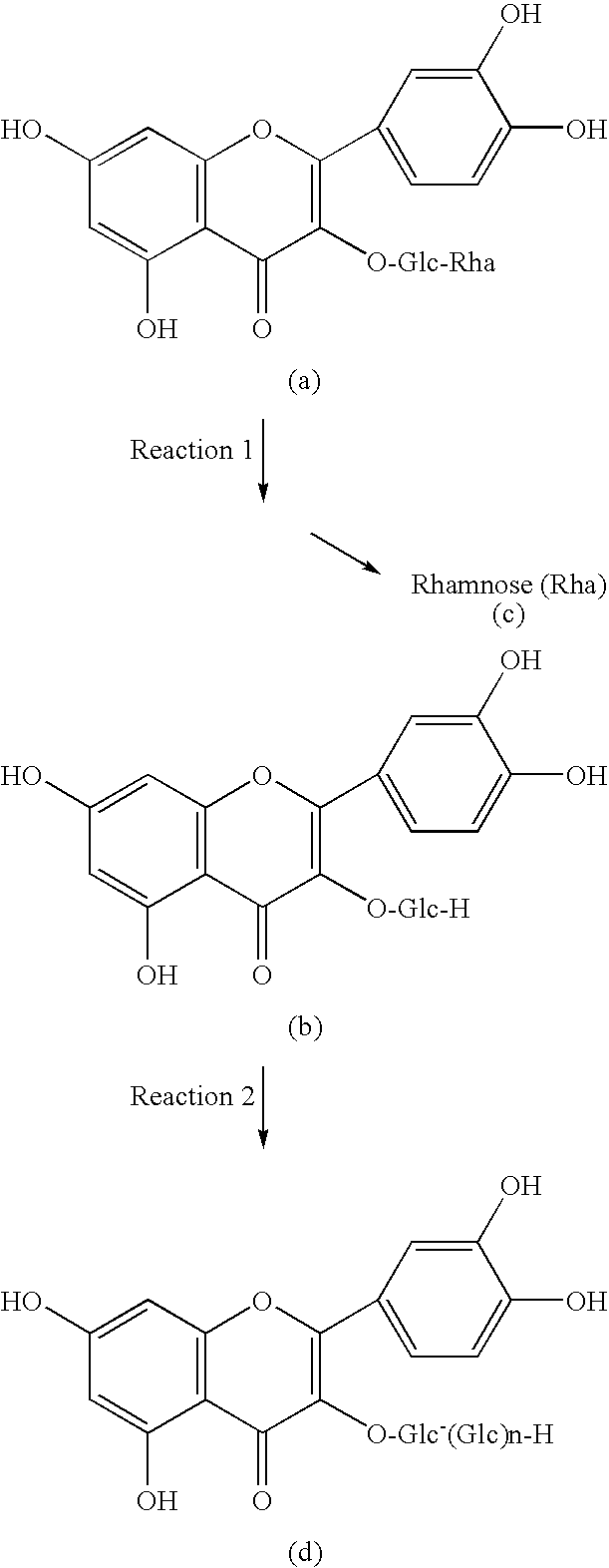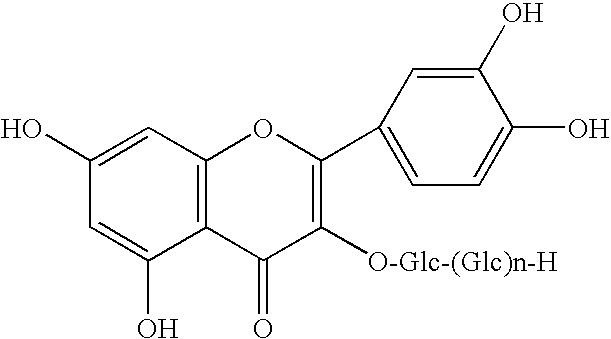Method for manufacturing alpha-glycosylisoquercitrin, intermediate product and by-product thereof
a technology of isoquercitrin and alpha-glycosylisoquercitrin, which is applied in the field of process for producing glycosylisoquercitrin and an intermediate product, can solve the problem of not being able to apply isoquercitrin to aqueous products
- Summary
- Abstract
- Description
- Claims
- Application Information
AI Technical Summary
Benefits of technology
Problems solved by technology
Method used
Image
Examples
experimental example 1
[0069]Rutin (5 g) was dispersed in about 90 ml of water. One of the various edible components (food additives) listed in Table 1 was added thereto in a proportion of 0.05 wt. % or 0.5 wt. %, and dissolved or dispersed. The mixture was heated to 72° C. The pH thereof was adjusted to 4.7 by pH adjustors (sulfuric acid, sodium hydroxide). Water was added to the mixture to a total volume of 100 ml. The reaction was initiated by introducing 1 ml of an aqueous solution of naringinase (manufactured by Amano Enzyme, Inc., trade name: naringinase “Amano”) prepared by mixing 0.02 g of naringinase (specific activity: 3000 U / g) with 10 ml of water. Five hours later, 4 μl of the reaction solution was sampled and dissolved in 50 μl N sodium hydroxide. A mixed solution of 15 volume % acetonitrile and 0.085 w / v % phosphoric acid was added (2 ml in total) thereto to stop the reaction. The reaction solution thus obtained was subjected to HPLC under the conditions described below. The amount of isoque...
experimental example 2
[0073]This experiment was conducted in the same manner as in Experimental Example 1 except that the food ingredients listed in Table 2 were used as edible components. The amount of isoquercitrin produced was calculated based on HPLC analysis, and the yield (%) thereof was obtained accordingly. The results are also shown in Table 2.
TABLE 2Food ingredientsFormConcentration (%)Yield (%)Control16.34Flour (soft flour)Powdery0.556.1Flour (strong flour)Powdery0.555.42RyePowdery0.555.07TriticalePowdery0.551.8Rice branPowdery0.550.4Wheat germPowdery0.549.11SoybeanPowdery0.547.81Wheat branPowdery0.546.75Adzuki beanPowdery0.546.27BarleyPowdery0.545.52BuckwheatPowdery0.543.4Foxtail milletPowdery0.543.9MilletPowdery0.541.8Job's-tearsPowdery0.535.17Barnyard milletPowdery0.533.05Corn starchPowdery0.542.2Potato starchPowdery0.0521.12Kudzu starchPowdery0.0522.71
[0074]The results show that treating rutin with a naringin-degrading enzyme in the presence of any of the edible components listed-above inc...
example 1
[0075]Rutin (5 kg) was dispersed in 100 l of water (temperature: 55° C.). To this mixture were added 10 g of naringinase (Amano Enzyme, Inc., trade name: naringinase “Amano”, Japan) and each of the edible components (food additives, food ingredients) listed in Tables 1 and 2. The amount of each edible component added was adjusted that to attain the concentration in the mixture prepared as shown in Tables 1 and 2 (0.5 or 0.05 wt. %). The pH of the reaction mixture was 4.7. The reaction solution was left to stand 24 hours at 72° C., and then cooled to 30° C. The components precipitated by cooling were recovered by filtration. Solid filtrates were washed with water and then dried to obtain isoquercitrin.
PUM
| Property | Measurement | Unit |
|---|---|---|
| Fraction | aaaaa | aaaaa |
| Fraction | aaaaa | aaaaa |
| Fraction | aaaaa | aaaaa |
Abstract
Description
Claims
Application Information
 Login to View More
Login to View More - R&D
- Intellectual Property
- Life Sciences
- Materials
- Tech Scout
- Unparalleled Data Quality
- Higher Quality Content
- 60% Fewer Hallucinations
Browse by: Latest US Patents, China's latest patents, Technical Efficacy Thesaurus, Application Domain, Technology Topic, Popular Technical Reports.
© 2025 PatSnap. All rights reserved.Legal|Privacy policy|Modern Slavery Act Transparency Statement|Sitemap|About US| Contact US: help@patsnap.com



